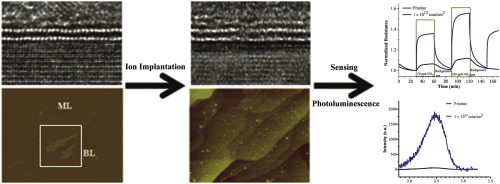Our official English website, www.x-mol.net, welcomes your
feedback! (Note: you will need to create a separate account there.)
Surface functionalization of epitaxial graphene using ion implantation for sensing and optical applications
Carbon ( IF 10.5 ) Pub Date : 2020-02-01 , DOI: 10.1016/j.carbon.2019.09.071 Priya Darshni Kaushik , Marius Rodner , G.B.V.S. Lakshmi , Ivan G. Ivanov , G. Greczynski , Justinas Palisaitis , Jens Eriksson , Pratima Solanki , Anver Aziz , Azher M. Siddiqui , Rositsa Yakimova , Mikael Syväjärvi , G. Reza Yazdi
Carbon ( IF 10.5 ) Pub Date : 2020-02-01 , DOI: 10.1016/j.carbon.2019.09.071 Priya Darshni Kaushik , Marius Rodner , G.B.V.S. Lakshmi , Ivan G. Ivanov , G. Greczynski , Justinas Palisaitis , Jens Eriksson , Pratima Solanki , Anver Aziz , Azher M. Siddiqui , Rositsa Yakimova , Mikael Syväjärvi , G. Reza Yazdi

|
Abstract Surface functionalization has been shown to allow tailoring of graphene lattice thus making it suitable for different applications like sensing, supercapacitance devices, drug delivery system and memory devices. In this work, surface functionalization of epitaxial graphene on SiC (EG/SiC) was done by ion beam technology (30 keV Ag− ions at fluences ranging from 5 × 1012 ions/cm2 to 5 × 1014 ions/cm2), which is one of the most precise techniques for introducing modifications in materials. Atomic force microscopy showed presence of nanostructures in ion implanted samples and Photoluminescence and X-ray photoelectron spectroscopy revealed that these are probably silicon oxy carbide. High-resolution transmission electron microscopy (HRTEM) showed decoupling of buffer layer from SiC substrate at many places in ion implanted samples. Further, HRTEM and Raman spectroscopy showed amorphization of both graphene and SiC at highest fluence. Fluence dependent increase in absorbance and resistance was observed. Gas sensors fabricated on pristine and ion implanted samples were able to respond to low concentration (50 ppb) of NO2 and NH3 gases. Detecting NH3 gas at low concentration further provides a simple platform for fabricating highly sensitive urea biosensor. We observed response inversion with increasing fluence along with presence of an optimal fluence, which maximized gas sensitivity of EG/SiC.
中文翻译:

使用离子注入对外延石墨烯进行表面功能化,用于传感和光学应用
摘要 表面功能化已被证明可以定制石墨烯晶格,从而使其适用于不同的应用,如传感、超级电容设备、药物输送系统和存储设备。在这项工作中,外延石墨烯在 SiC (EG/SiC) 上的表面功能化是通过离子束技术完成的(30 keV Ag− 离子,通量范围从 5 × 1012 离子/cm2 到 5 × 1014 离子/cm2),这是一种引入材料改性的最精确技术。原子力显微镜显示离子注入样品中存在纳米结构,而光致发光和 X 射线光电子能谱表明这些可能是碳氧化硅。高分辨率透射电子显微镜 (HRTEM) 显示,在离子注入样品的许多地方,缓冲层与 SiC 衬底分离。更多,HRTEM 和拉曼光谱显示石墨烯和 SiC 在最高能量密度下均发生非晶化。观察到吸光度和电阻的通量依赖性增加。在原始和离子注入样品上制造的气体传感器能够响应低浓度 (50 ppb) 的 NO2 和 NH3 气体。检测低浓度 NH3 气体进一步为制造高灵敏度尿素生物传感器提供了一个简单的平台。我们观察到随着注量增加的响应反转以及最佳注量的存在,这使 EG/SiC 的气体灵敏度最大化。检测低浓度 NH3 气体进一步为制造高灵敏度尿素生物传感器提供了一个简单的平台。我们观察到随着注量增加的响应反转以及最佳注量的存在,这使 EG/SiC 的气体灵敏度最大化。检测低浓度 NH3 气体进一步为制造高灵敏度尿素生物传感器提供了一个简单的平台。我们观察到随着注量增加的响应反转以及最佳注量的存在,这使 EG/SiC 的气体灵敏度最大化。
更新日期:2020-02-01
中文翻译:

使用离子注入对外延石墨烯进行表面功能化,用于传感和光学应用
摘要 表面功能化已被证明可以定制石墨烯晶格,从而使其适用于不同的应用,如传感、超级电容设备、药物输送系统和存储设备。在这项工作中,外延石墨烯在 SiC (EG/SiC) 上的表面功能化是通过离子束技术完成的(30 keV Ag− 离子,通量范围从 5 × 1012 离子/cm2 到 5 × 1014 离子/cm2),这是一种引入材料改性的最精确技术。原子力显微镜显示离子注入样品中存在纳米结构,而光致发光和 X 射线光电子能谱表明这些可能是碳氧化硅。高分辨率透射电子显微镜 (HRTEM) 显示,在离子注入样品的许多地方,缓冲层与 SiC 衬底分离。更多,HRTEM 和拉曼光谱显示石墨烯和 SiC 在最高能量密度下均发生非晶化。观察到吸光度和电阻的通量依赖性增加。在原始和离子注入样品上制造的气体传感器能够响应低浓度 (50 ppb) 的 NO2 和 NH3 气体。检测低浓度 NH3 气体进一步为制造高灵敏度尿素生物传感器提供了一个简单的平台。我们观察到随着注量增加的响应反转以及最佳注量的存在,这使 EG/SiC 的气体灵敏度最大化。检测低浓度 NH3 气体进一步为制造高灵敏度尿素生物传感器提供了一个简单的平台。我们观察到随着注量增加的响应反转以及最佳注量的存在,这使 EG/SiC 的气体灵敏度最大化。检测低浓度 NH3 气体进一步为制造高灵敏度尿素生物传感器提供了一个简单的平台。我们观察到随着注量增加的响应反转以及最佳注量的存在,这使 EG/SiC 的气体灵敏度最大化。






























 京公网安备 11010802027423号
京公网安备 11010802027423号